FunBITS: Strava Makes Exercise Social and Virtually Competitive
I’ve joined a new social network, but you probably won’t want to follow me.
For me, social networks often prove tedious and uninteresting for one big reason: lack of context. I’m interested in nearly everything about only a very few of my closest friends; the majority of my online friends and acquaintances fall into specific contexts: technology, running, local, high school, and, well, that’s about it. I like talking and interacting with these people in those contexts, but not necessarily otherwise. Just because I enjoy hearing someone’s thoughts about the Mac, for instance, doesn’t mean I’m interested in any of their other hobbyhorses.
Facebook attempted to address this problem with lists, so you could see only what people you’d sorted into a particular list were saying. And Google+ went one step further with circles, which let you direct posts to a certain group of people who would theoretically be interested. Both are ultimately unsuccessful: just because you put someone in a list doesn’t prevent them from posting on unrelated topics, and just because it’s possible for people to focus their posts to specific groups doesn’t mean they will.
Enter Strava, which at its heart is a social network for athletes. It resolves the context problem by making the primary type of post the workout. If you’re not a runner, cyclist, or triathlete who trains with friends, you’re probably thinking, “How massively boring!” But for those of us in such communities, seeing each other’s workouts and races in a scrolling activity feed is interesting. (Note that until you join Strava, you can’t see nearly as much of an athlete’s data, even when it’s otherwise public.) I care about what my running friends are doing each day, and I like seeing the crazy workouts my triathlete and ultra-marathoner buddies put up. When I run with my friends in the
High Noon Athletic Club at Cornell, previous days’ workouts or the weekend’s races are a focus of conversation, and Strava allows such things to move online as well. That enables me to keep tabs on friends who have moved away, too.
You can enter workouts into Strava in a variety of ways, though the most popular are via the free GPS-enabled Strava app (for iOS and Android), a GPS watch like the Garmin 620 that I’m now using, or by typing in the distance and time manually. For each workout, you can enter a title and a description, and those bits of metadata are what generate much of the interaction. I had a bad
fall on trails a few weeks ago that prevented me from running for a bit, and a number of friends have offered condolences and support throughout the recovery, as my running distances and paces dropped off, and then started to return to normal. For each workout, you can give “kudos,” which is a bit akin to clicking a Facebook “like” button, or you can engage in a back-and-forth comment thread attached to the workout.
If that were it, Strava would never have taken off since its founding in 2009. The key to Strava is that it feeds our competitive urges, both internal and external, by recording and comparing segment times. Whenever you track a run or a ride with the Strava app or a GPS watch, Strava looks at the course and pulls out the times for particular segments that users have defined, comparing them against both your own past results and those of other people. Have a particularly good workout and Strava pats you on the back and rewards you
with a variety of virtual medals, and possibly even a CR (course record, for runners) or a KOM/QOM (king/queen of the mountain, for cyclists). And, of course, Strava makes sure that everyone else can see that you’re at the top of the leaderboard for that segment, thus encouraging them to try to take you down. Even if you stand no chance of topping the overall leaderboard, you can see how you match up against only people you follow, or against people in your age group or weight class (the last two are limited to Strava Premium users who pay $6 per month or $59 per year).
Strava also has frequent “challenges” that motivate those who join to run a certain number of kilometers in a month, do a virtual race at a standard distance, or climb the most hills. They’re popular — 20,000 to 150,000 people take part in challenges, which also unlock virtual badges and sometimes discounts on gear.
Don’t get the impression that it’s all about competing with other people, though. Being able to see how you’ve performed on particular courses or segments in the past is motivation to do better in the future. And if motivation to get out and exercise at all is your bugbear, the mere act of posting the results in public has been shown to encourage future actions, as does the satisfaction of completing the challenges. Before I started using Strava for real in January 2014, I relied on a different site that stored my GPS-tracked
runs but lacked the social (and competitive) aspects of Strava. I’d often go days or weeks before getting around to uploading the data; with Strava, I upload as soon as I get home so I can get credit and that little social thrill from posting.
As on Twitter, Google+, and LinkedIn, you follow people in Strava; they can follow you back if they wish, but they’re not required to, as Facebook forces. Although Strava recommends a few elite athletes who use the service, I’m interested only in people I know well (wherever they may live) or local athletes I know less well but see at races sometimes. You can also create and join clubs, so if you run or bike with a club in real life, it can have a virtual presence on Strava as well. For the club, you can see at a glance who has done what in the past week, and there’s a standard discussion feature that can be used to set up future events or chat in general. My limited experience indicates that club discussions on Strava stay very
focused on the topic, which is nice.
The previous site I used was basically a running log, a staple of any runner’s life that tracks what you’ve done and allows you to see various key statistics, such as how many miles per week you’re doing, how many miles you have on a particular pair of shoes, and what your PRs (personal records) are for particular races and distances. Strava meets those needs as well, with attractive training log and calendar screens (with running, riding, and multi-sport displays) that do a good job of summarizing what you’ve done.
All of this is available for free, and although Strava hasn’t published official numbers, these features have attracted well over 1 million users; the company’s CEO predicted that Strava would have 10 million users by the end of 2014. What sets Strava apart from other social networking sites is that 70 percent of the site’s users are active, uploading two or more workouts per week, and 20 percent of users pay for Strava Premium. In other words, unlike most
social networks, Strava actually makes money directly from loyal users, rather than from ads. (The company also sells some apparel and a variety of accessories, and some challenges are sponsored, but I doubt those are significant revenue generators.)
I haven’t subscribed to Strava Premium yet for reasons I’ll explain shortly, but doing so adds a number of potentially interesting features for those who are either more competitive or more involved in their training. For runners, Strava Premium adds a “suffer score” that uses heart rate data to quantify how hard workouts are, time and distance goals, filtered leaderboards, better pace and race analysis, real-time segments, locations of friends during their workouts, a trophy case for virtual awards, and a heat map of the locations in which you’ve run. For bikers, many of the same benefits apply, along with power analysis for those using power meters, GPX download for transferring rides others have done to a Garmin Edge bike
computer, and indoor training videos. Strava Premium features are exposed in the interface, so you can always see what you’re missing, but it’s also easy to stick with the free service.
That’s what I’ve done, not so much because I’m not competitive (I am) or because I’m not involved with my training (I love looking at pace stats). My problem is twofold. First, Strava has a lot of competition, and many of the people I train with use other logging software or sites, sometimes due to preference and sometimes due to inertia (Ithaca isn’t the most wired of towns). Strava gains a lot of users based on the network effect — if enough friends do it, you’ll want to as well — but the network effect works both ways. If too few of my friends end up using Strava, the social aspect may fade away over time.
Second and more concerning, Strava has a basic philosophical relationship with data that troubles me. Clearly, Strava records and crunches a vast amount of data about each workout, but the company’s programmers have made what I believe is a dubious decision in focusing on GPS tracks and ignoring other workout metadata, such as when the user pressed a watch button. This has been teased out in a lengthy support thread about the difference between moving time and elapsed time — essentially, Strava prefers moving time (ignoring the time when you’re stopped) and reports elapsed time only when you mark a run as a race. For biking this
might be more acceptable (bikers move more quickly, and are less likely to be in forests and other places with bad GPS reception), but for runners, losing GPS signal briefly is commonplace, no matter what the recording device, resulting in workouts that have incorrect distances and wacky times and paces.
Even when you mark a run as a race, the data may be off. I ran a 1600 meter track race last month in 5:09, and my Garmin 620 captured that time correctly. But when I uploaded the workout to Strava and marked it as a race, it said my time was 5:07. That’s because the Garmin 620 apparently didn’t record a GPS track point for the first two seconds of the race. So Strava properly switched from moving time to elapsed time because of me marking it as a race, but because it ignored the watch’s actual elapsed time and calculated it from the GPS tracks, it still got the time wrong (the pace was even worse — a mile is 1609 meters, so my pace was more like 5:11, not Strava’s bogus
4:59. And while I would have liked running 2 seconds faster or to have that fast pace, it’s embarrassing to have to explain that it’s wrong.
Why don’t I just edit the workout to fix the incorrect data? This too is bothersome — Strava doesn’t allow editing of uploaded workouts, apart from setting the workout type, choosing the equipment (shoes or bike) used, and entering the title and description. (And even doing that sometimes results in an endless progress spinner.) You can of course delete an incorrect workout and reenter it manually with correct data, but then you lose the map of where you were and any pace or heart rate data that may be associated with
the original automatically generated workout.
Being able to edit that data would resolve my discomfort with Strava’s cavalier attitude about data accuracy — for the vast majority of workouts, I don’t care if the data is a little off. But when I run a track race or a wheel-certified road race, the distance on the ground is more accurate than whatever my Garmin 620 records, and I should be able to override Strava’s bad data with my good data. Because of this reliance on weak GPS data, Strava doesn’t automatically calculate true PRs (it does calculate “best
estimated efforts,” which are thus entirely random); you must instead type PRs in manually.
It’s too bad, since I was about to subscribe to Strava Premium before I realized these deficiencies, and the company’s responses in that support thread don’t reveal much understanding or sympathy. I realize that I’m probably in a tiny minority of Strava users, being a data-savvy competitive runner who cares about every last second in some races, but it’s hard to entrust all my hard-earned training data to a company that doesn’t seem to be concerned with accuracy when it really matters.
For now, I’ll keep using Strava for its social aspects and its overview of training information, both of which I prefer to Garmin Connect, which automatically records all my data from my Garmin 620 as well, but my recommendation of the site has to be tempered for people like me who care about their exact results.
But I don’t want to end this review on a negative note. I may be a competitive and geeky runner, but I strongly support anyone who wants to improve their fitness, at any level. I love running and riding, and I encourage everyone to get out and move more. If Strava can play a role in helping you exercise, whether it’s by jogging around the block, running your first 5K, or training to complete a charity bike ride, that’s all good.

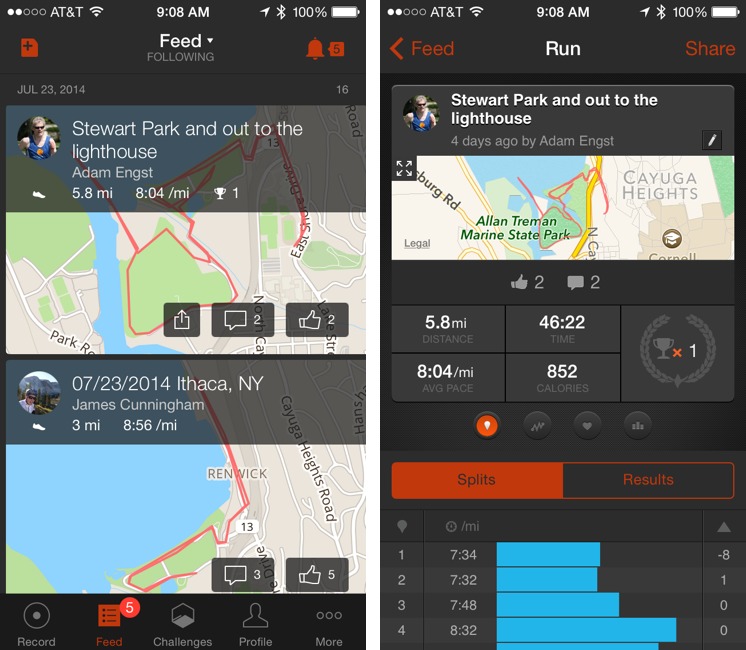
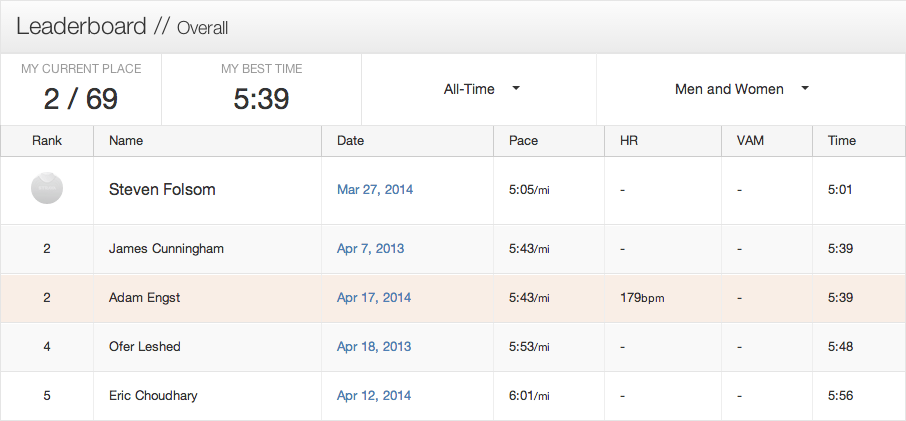
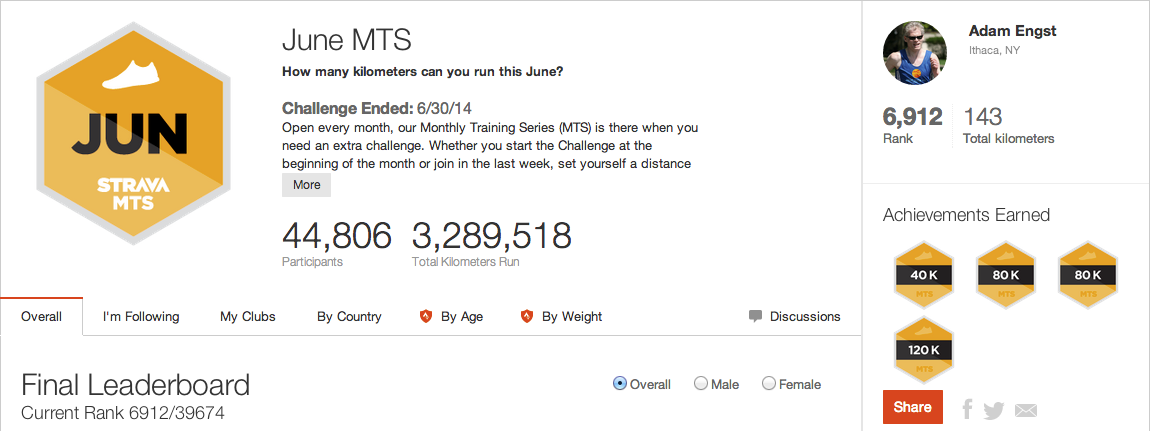
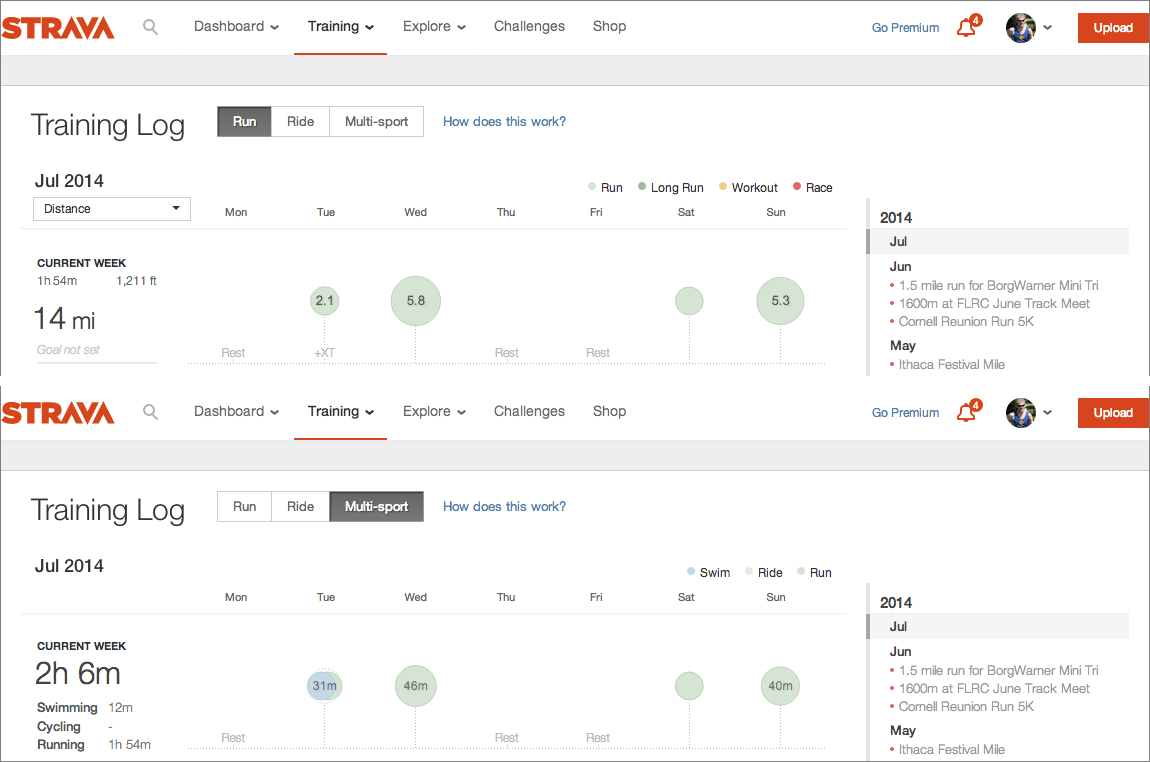
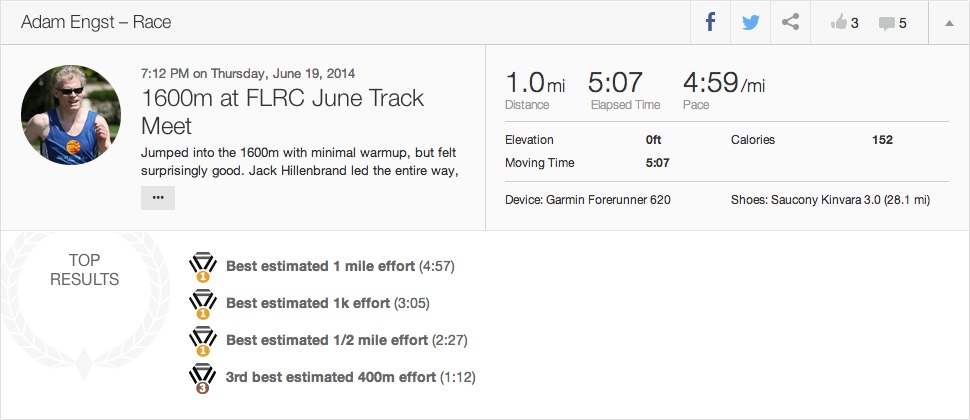

Adam said: "(bikers move more quickly, and are less likely to be in forests and other places with bad GPS reception)"
Come and visit here and we will go for a MTB ride in the forest across the road. You might revisit your statement.
:)
But that's interesting to know, so now I'll have to revisit my rides!
Rob
I had a feeling I'd get a mountain biker popping up here. :-) I have to assume mountain bikers are more likely to suffer from Strava's unfortunate attitudes toward data accuracy, given the slower speeds and dense tree cover affecting GPS reception.
Some of the people who are the most irritated are ultramarathoners, since Strava can lose multiple hours of an ultra trail race.
And on a funny note, when I was first experimenting with Strava, I left it on in the car on the way home. I drove up a hill and a few minutes later received a notification that I was king of the hill, by a very wide margin.
That was good impetus to learn how to delete activities though I did wonder why they didn't cross-check the data. How many cyclists can ride 50km per hour up steep hills?
Yeah, I ran into this in the other direction - some guy had biked a course I ran, but left it as a ride rather than a run. Needless to say, I couldn't compete with his faster-than-world-record mile pace on any of the segments.
Luckily, there's a way to contest an entry, by clicking the wrench icon for that activity. Strava support presumably then removes it from all the segment leaderboards.
In your case, since there's no way to edit the event (boo!), I think the only solution is to delete and recreate. It's a shame they don't detect such errors at import and offer the opportunity to edit.
Yes, flagging an entry removes it from the segment leaderboards. I saw this last night when someone loaded a bike ride as a run, complete with world record pace.
I use Strava also mainly for biking and some "running", and I can keep track of which bike I used.
My personal favorite is when I used Strava to record part of my ride on a Bullet train in Japan! I recorded it as a 186 mph windsurfing activity on dry land : )
I ran a 5K, and did have issues with the gun time versus when I got to the start line. I also forgot to hit finish once I crossed the line, so the end looked (and was) a truly random walk as I tried to breathe again : ) but I could at least crop out the start and finish to more closely match the 5K course.
Ran across another good article about Strava, if you want to read more.
http://www.outsideonline.com/fitness/biking/How-Strava-Is-Changing-the-Way-We-Ride.html
That's interesting. Tom Vanderbilt wrote that great book on "Traffic", half a decade ago, and has been a savvy observer of all sorts of transport modes.
As a cyclist (and occasional runner), I use Strava to track my own personal records and compare myself against the fast guys in my neck of the woods. The GPS errors are sometimes annoying, as when I did a 2.1-mile, 7% grade climb to a mountain summit only to find afterwards that my GPS lock was too inaccurate for it to count. But most of the time, GPS works OK, and since I'm mostly measuring myself against my previous efforts, I don't really care.
I signed up for the paid version mostly because I like the service and don't want it to fail because it doesn't generate enough revenue. It's the same reason I pay for RideWithGPS, which is hands-down the best current site for planning bike rides, hikes, and runs.
Thanks for the pointer to RideWithGPS - Tonya and I have used a variety of those sites over the years, but we do so infrequently enough that we've never really remembered one as being better than another.
Have you compared RideWithGPS to Strava's own route generation tool? I gather that's fairly new, and we haven't actually built a route this summer, so I totally forgot about it until reading your comment. The main advantage I see is that the Strava app could theoretically be giving directions as well as recording the ride. (And I wonder if the route has any relationship to the data at the end?)
FWIW, here's the iPhone 5 case that I use for mounting my iPhone on my Elliptigo's handlebars. We just got Tonya the 5s version as well. It does a good job of mounting and protecting the iPhone.
http://www.amazon.com/dp/B00AQ82A5E/?tag=tidbitselectro00
There are a few other apps that post to Strava. I use the excellent iSmoothRun on my iPhone, which works for both bike and run (or both) and links the GPS, sensors (footpods, etc.) and accelerometer.
iSmoothRun seems to smooth out problems in the GPS data, so the general accuracy is pretty good. (I haven't tried a footpod yet, but I think it should work even better.)
I think the site is well thought out, better than most of the competition. The comments and kudos are nice, and it's easy to pull up a calendar showing how much you've run over the month or week. It's also really easy to pull out long runs/rides and races when you've tagged them.
And glad to see you post a review Adam!
Yes, I didn't want to get into too much comparison, but I've looked at quite a few of these sites in the past, and overall, I think Strava has done the best job with interface by far.
I'd be curious if iSmoothRun takes care of the GPS dropping problem - have you done many deep woods with it, where the GPS lock would be weak?
The one thing I need to investigate with my Garmin 620 is resetting the the GPS interval from Auto to 1 second. It's possible that will reduce some of the dropouts as well.
(And for those who don't know, which will be just about everyone, Geoff is one of my High Noon Athletic Club friends who ran with me while he was a postdoc at Cornell. Since he's now in Pittsburgh, Strava is the closest we get to running together these days.)
The woods aren't quite as deep as Ithaca, but I've been running a lot of trails here. When the GPS cuts out, iSmoothRun uses the accelerometer as a pedometer. It's not perfect, but much better than other apps I've tried. Basically, it seems to track cadence and average stride length, so when there's a cutout, it estimates from strides.
I've seen much better accuracy than other apps, usually within 0.05 miles on repeated routes. Not so great for track workouts, but so far woods and other tough GPS spots seem fine.
(I also suspect Apple's use of cell tower triangulation helps too.)
Incidentally, I've read TidBITS since around issue 100. So when I saw Adam at the High Noon runs, I thought "hey, that's Adam Engst from TidBITS!" :-)
What I find most interesting about this is that iSmoothRun must still be kicking out GPS track points that Strava understands, given my understanding of how Strava pays attention only to that data. So perhaps iSmoothRun is actually extrapolating GPS tracks out of the accelerometer data and location services information.
Also Strava has generated a product called Strava Metro that is designed to help improve cycling and running infrastructure. This in turn will generate more cyclists. http://metro.strava.com/
A way to use big data for good while completely protecting the users privacy. This is done by not selling the raw GPS tracks but selling back a table that reference the street network.
In respect to the routing engines of Strava and RideWithGPS: they are dramatically different with Strava routing on an OSM basemap that has been enhanced with cycling and running data activity. RidewithGPS still is restricted to using the Google Basemap or OSM basemap with road class routing which was built for cars.
Cheers and great article
Thanks so much for sharing the details about Strava Metro - I wasn't aware of it before. It's a great use of all that data, especially when it comes to helping cities become more bike- and pedestrian-friendly. I've always been amused to see where college students walk on large, grassy campuses like Cornell - they identify shortcuts that the landscape architects never see. This sort of big data - where bikers and runners REALLY go, could help cities plan accordingly.
For a ton more data visualization, check out VeloViewer.
http://veloviewer.com/
Strava has now added an interesting Effort Comparison tool, so you can see how your effort waxed and waned during a segment.
http://blog.strava.com/whats-your-best-effort-see-how-it-compares-8480/